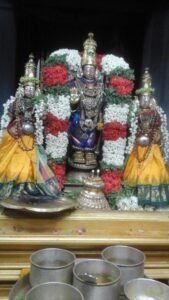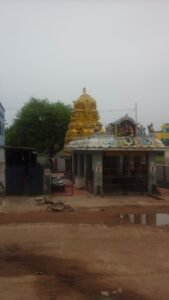SrI: SrImathE SatakOpAya nama: SrImathE rAmAnujAya nama: SrImath varavaramunayE nama:
History
This temple finds mention in “brahmANda purANam”, with the following events:
“hiraNya kashyap was an asura, who proclaimed that he himself was the Lord of his land (both earth and swargam) and that there is no other God. His son, prahlAdhAzhwAn, was a great devotee of SrIman nArayaNan. This constantly angered hiraNya kashyap, who had performed many penances and won several boons from brahmA and siva, with a unique boon by which he cannot be killed by man or beast, in daylight or darkness, inside or outside the house, by any of the known weapons, neither on the earth nor on the sky, not by cosmos, fire, water, wind or earth.
prahlAdh never called SrIman nArayaNAn to protect him, but seeing his plight every time that his father abused him, SrIman nArayaNan decided to put an end to his troubles and took the form of ‘narasimha’, a combination of lion’s face and man’s body. He came out of a pillar when hiraNya kashyap teasingly asked prahlAdh whether his Lord was present in the pillar also. In his anger, ‘narasimha’ killed hiraNya kashyap with his bare hands, using his nails, by keeping hiraNya kashyap’s body on his lap, at twilight time, on the door step, thus fulfilling all the conditions for the asura’s death.
‘narasimha’ had three eyes (thrinEthradAri) when he killed hiraNya kashyap. Around that time, the village singapperumAL kOyil (it was then called sengunRam) was surrounded by forests and sage jApAli was doing his penance in the forest. He begged the Lord to present himself as ‘narasimha’, the same form with which he killed the asura. The Lord fulfilled his desire and presented himself as thrinEthradhAri (with three eyes) and in an angry frame of mind (ugra vadivam/form). The sage asked the Lord to remain in the village in the same form and thus the mUlavar that we see today came into existence.
The temple was completed during the pallava kings’ era as a rock temple, between the periods of narasimha pallavan and paramEsvara pallavan (circa 600 CE), as per historians (ref ‘AgamakOsa – kalpathAru Research Academy’, bengalUru, 560018). There is an inscription in the rock behind SrI ANdAL sannidhi dating to chOzhA king 1st rAja rAja chOzhA (late 10th century – early 11th century, CE).
Since the temple was completed as a rock temple, there is no circum-ambulation around the perumAL sannidhi. Instead one has to go around the hill (around 100 steps in all, both up and down) to perform circum-ambulation. Thus, the ‘thrinEthra’ dharshan and ‘giri valam’ (circum-ambulation around the hill) are special features in this ancient temple.
The decad that thirumangai AzhwAr has sung on narasimha in singavELkunRam, in his periya thirumozhi, (1st centum, 7th decad) is sung everyday by the descendants of SrI mudhaliyANdAn in this temple. SrI mudhaliyAndAn’s descendants have been accorded 1st thIrththam, and they take the lead in aruLichcheyal gOshti, vEdha pArAyaNam etc.
vimAnam: praNavakOti vimAnam
pushkariNi: sudhha pushkariNi
perumAL’s mangaLa slOkam:
lakshmi parIshkrutAnkAya prahlAdA AhlAdha kArINE
pAtalAdri nivAsAya SrI nrisimhAya mangalam
Deities/uthsavams
There are several sannidhis and uthsavams that happen for the emperumAns, AzhwArs and AchAryas in this dhivya dhEsam.
- Presiding deity
- mUlavar – pAtalAdhri narasimhar swAmy
- uthsavar – prahlAda varadan with SrI dhEvi and bhUmi dhEvi nAchiyArs
- thanikkOyil nAchiyArs (separate thAyAr sannidhis)
- ahObhilavalli thAyar
- AndAL
- lakshmi narasimhar
- AzhwArs and AchAryArs
Outside the temple:
- thiruvadi (hanumAn) sannidhi
- mudhaliyANdAn thirumALigai, with sannidhi for SrI ranganAthar
perumAL is in sitting posture (vIRRirundha thirukkOlam). perumAL has sudharsana chakram in his top right hand and sankham in his top left hand. His lower right hand is in ‘abhaya’ mudhrA and lower left hand is resting on his left thigh. He has folded his right thigh and his left leg is resting on a lotus. There are ‘pancha bErars’ in perumAL sannidhi, as well as nardhana krishNan and sudharsanar. He has thrinEthram (three eyes), salagrAma hAram, sahasranAma hAram and lakshmi hAram.
Since narasimha avathAram took place during twilight time, during every pradhOsham (two days before amAvAsya or pourNami) special thirumanjanam and naimiththika ArAdhanam are performed for pradhOsha narasimha mUrthy
uthsavams
- chithrai
- chithirai vishu puNyakAlam
- narasimhar jayanthi
- rAmAnujar jayanthi (10 days)
- chitrA pourNami
- vasantha uthsavam
- kadai veLLi
- vaikAsi
- brahmOthsavam (10 days)
- Ani
- periyAzhwAr uthsavam
- Adi
- gajEndra mOksham
- jyEshtAbhishEkam
- thiruvAdippUram
- AvaNi
- SrI jayanthi – rOhiNi/ashtami followed by uriyadi uthsavam on the next day
- pavithrOthsavam (5 days)
- purattAsi
- navarAthri uthsavam – 9 days
- vijaya dhasami (pArivEttai)
- aippasi
- maNavALa mAmunigaL uthsavam (10 days)
- dhIpAvaLi
- kArthigai
- kArthigai dhIpam
- mArgazhi
- dhanur/mArgazhi mAsam kramam (30 days)
- hanumath jayanthi (Eka dhina lakshArchanai)
- adhyayana uthsavam (pagal paththu and irAppathu)
- vaikuNta EkAdhasi
- bhOgi thirukkalyANam
- thai
- sankarAnthi
- AndAL kanu (evening – pAri vEttai)
- thaippUsam
- ratha sapthami (7 vAhanams)
- mAsi
- theppa uthsavam
- perumAL dhavana uthsavam – Eka dhina lakshArchanai
- thAyAr dhavana uthsavam
- AndAL dhavana uthsavam
- panguni
- panguni uthram
- gandhappodi uthsavam
- ugAdhi
kramam (routine)/timings
Timings
- Morning: 7.30 to 12 noon
- Evening: 4.30 to 8.30
Timings are subject to change during uthsava kAlam
During the months of Adi and thai, on every Friday evening, thAyAr has purappAdu inside the temple, with siriya thirumadal being chanted.
Contacts
HR & CE administered temple
Executive Officer,
singapperumAL kOyil
kAnchIpuram district – 603 204
Location:
The temple is located on NH 45, 48 km from chennai, 8 km before chengalpattu.
It is a short distance from singapperumaL kOyil railway station / bus stand. EMUs between chennai beach and chengalpattu stop at this station, and there are trains from 4.30 in the morning to 10.30 in the night, either way.





